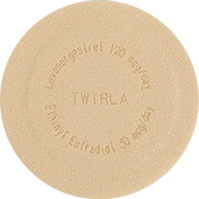

GET TO KNOW THE
only weekly birth control patch that delivers a low dose of estrogen
Check Twirla® daily and after water exposure to make sure the edges haven’t lifted.
View a snapshot ofour consumer advertising



Check Twirla® daily and after water exposure to make sure the edges haven’t lifted.
View a snapshot of
Twirla® is a weekly hormonal birth control patch for women with a body mass index (BMI) less than 30 kg/m2 who can become pregnant. Twirla is less effective in women with a BMI of 25 kg/m2 or more to less than 30 kg/m2 and should not be used in women whose BMI is 30 kg/m2 or more.
Do not use TWIRLA if you have or have had blood clots; history of heart attack or stroke, high blood pressure that medicine cannot control, any condition that makes your blood clot more than normal, certain heart valve problems; smoke and are over 35 years old; BMI ≥30 kg/m2.
TWIRLA is also not for women who have diabetes and are over 35 years old, diabetes with high blood pressure or kidney, eye, nerve, or blood vessel damage, diabetes for longer than 20 years; have had breast cancer or any cancer that is sensitive to female hormones; certain kinds of severe migraine headaches; have liver problems or liver tumors; unexplained bleeding from the vagina; who are or may be pregnant; or who take hepatitis C drugs containing ombitasvir/paritaprevir/ritonavir, with or without dasabuvir, as this may increase levels of liver enzymes in the blood.
TWIRLA may not be a good choice for you if you have ever had depression; jaundice (yellowing of the skin or eyes) caused by pregnancy (also called cholestasis of pregnancy) or related to previous use of hormonal birth control.
TWIRLA increases the risks of serious side effects, including blood clots, stroke, or heart attack, especially in women who have other risk factors. These can be life-threatening or lead to permanent disability. This increased risk is highest when you first start using hormonal birth control and when you restart the same or different hormonal birth control after not using it for a month or more. Treatment with TWIRLA should be stopped at least 4 weeks before and through 2 weeks after major surgery.
The most common side effects reported by women using TWIRLA in a study were skin reactions at the patch site, nausea, headache, menstrual cramps, and weight gain.
These are not all the possible side effects of TWIRLA. Call your health care provider for medical advice about side effects.
You may report side effects to FDA at 1-800-FDA-1088 or at www.fda.gov/medwatch.
TWIRLA is a birth control patch for women with a BMI less than 30 kg/m2 who can become pregnant. It contains two female hormones, a progestin called levonorgestrel, and an estrogen called ethinyl estradiol. TWIRLA may not be as effective in women with a BMI of 25 kg/m2 or more. If you have a BMI of 30 kg/m2 or more, please talk with your health care provider about which method of birth control is right for you.
You should not use TWIRLA any earlier than 4 weeks after having a baby or if you are breastfeeding.
Hormonal birth control methods help to lower the chances of becoming pregnant when taken as directed. They do not protect against HIV infection (AIDS) and other sexually transmitted infections (STIs).
The risk information provided here is not complete. To learn more, review the TWIRLA Patient Information and talk with your health care provider or pharmacist.